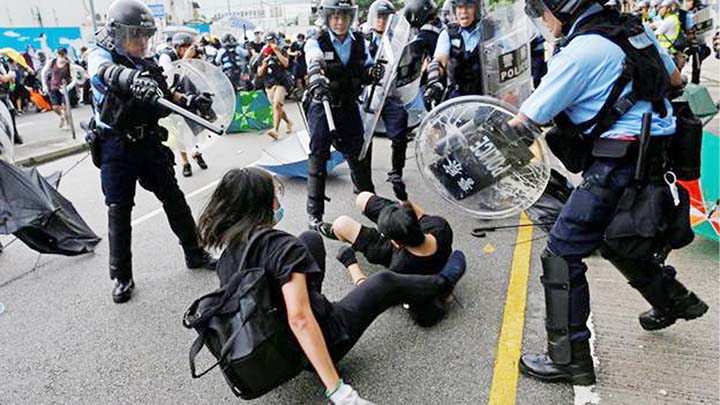
Police in Hong Kong have clashed with protesters marking the anniversary of its handover from UK to Chinese rule.
In chaotic scenes on Monday, police used pepper spray and batons to contain protesters outside a venue hosting an annual flag-raising ceremony.
A small group of protesters also smashed into the government building.
This is the latest in a series of protests against a controversial bill that would allow extraditions to mainland China.
The government has agreed to suspend it indefinitely, but the rallies continue and Chief Executive Carrie Lam is facing ongoing calls to resign.
Hong Kong, a former British colony, has been part of China since 1997 under a “one country, two systems” deal that guarantees it a level of autonomy.
Pro-democracy events are held every year to mark the handover. Large crowds were seen marching through the streets on Monday afternoon.
The flag-raising ceremony to mark the handover took place inside the Hong Kong Convention and Exhibition Centre, amid a heavy police presence.
Demonstrators began blocking several roads near the venue early on Monday morning, Authorities say, using items like metal and plastic barriers to block the way.
Outside the Convention and Exhibition Centre, police officers equipped with shields and batons clashed with hundreds of protesters around 30 minutes before the ceremony. Police also used pepper spray to disperse the crowd. At least one woman was seen bleeding from a head wound after the clashes, news agency AFP says.
A police statement condemned “illegal acts” by protesters who, it said, had taken iron poles and guard rails from nearby building sites.
The force later said 13 police officers had been taken to hospital after protesters threw an “unknown liquid” at them. Some were said to have suffered breathing difficulties as a result.
Around lunchtime, a breakaway group of protesters moved to the Legislative Council building (LegCo), where the government meets. A small group of protesters continually rammed a metal trolley against the glass doors of the building as some on the sidelines yelled words of encouragement.
The group later succeeded in smashing in the door, but did not make their way into the building, where riot police could be seen waiting inside.
Some democratic lawmakers pleaded with protesters to stop trying to force their way in.
Most gathered around the government building then dispersed on Monday afternoon, as crowds gathered at the main pro-democracy march.
Speaking at the flag ceremony in the morning, Hong Kong’s leader Carrie Lam pledged to spend more time listening to the public.
“I will learn the lesson and ensure that the government’s future work will be closer and more responsive to the aspirations, sentiments and opinions of the community,” she said. It was Ms Lam’s first public appearance since 18 June, when she issued an apology for her handling of the extradition law.
Hong Kong has a history of peaceful protests and for the most part these demonstrations were calm, barring these clashes with police.
The overwhelming sense I got after speaking to many here is that there is a real anger amongst young people and frustration with how Hong Kong is being run.
They want protesters detained released, the bill withdrawn and Carrie Lam to resign.
Away from the anger I also saw remarkable scenes of cooperation. One by one people passed umbrellas, helmets and cling film to each other as they stood firm against the police who had brought pepper spray and batons to fight back.
As evening fell, the crowds swelled – as the protesters were joined by families with young children who had joined the pro-democracy march that takes place every year to mark the handover of Hong Kong to mainland China.
But this year it’s taken on a special significance – a chance to show the government here that they won’t give to their city without a fight.
Hong Kong’s “one country, two systems” system allows it freedoms not seen in mainland China, including judicial independence.
The extradition bill raised concerns for that status.
Critics of the bill feared it could be used to target opponents of the government in Beijing, and to bring Hong Kong further under China’s control.
On 12 June police used tear gas and rubber bullets to disperse crowds marching against the bill – the worst violence in the city in decades.
Eventually, the demonstrations forced the government to apologise and suspend the planned extradition law.
However, many protesters said they would not back down until the bill had been completely scrapped.
Many are still angry about the level of force used by police on 12 June, and have called for an investigation.
“The Hong Kong police’s well-documented use of excessive force against peaceful protesters urgently demands a fully independent investigation,” said Sophie Richardson, China director at Human Rights Watch, in a statement.
However, there have also been smaller demonstrations by the territory’s pro-Beijing movement.
On Sunday, thousands of pro-Beijing protesters rallied in support of the Hong Kong police.
One pro-Beijing protester told AFP police were just trying to “maintain order”, calling the anti-extradition protesters “senseless”.

